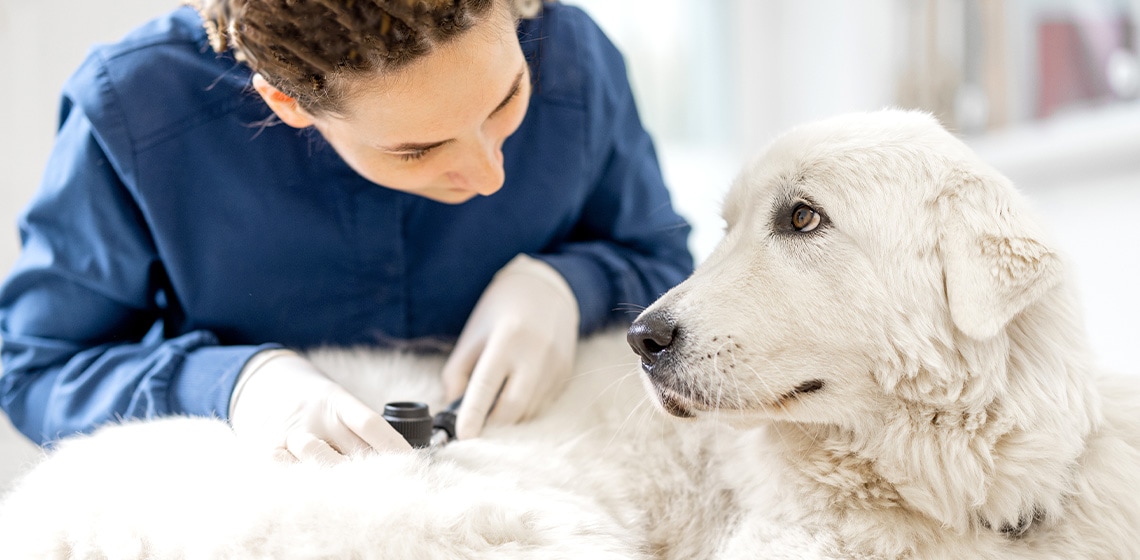If one of your furry family members is getting a bit older, they might have developed a skin tag or two. While skin tags are a little unsightly, are they anything to worry about? And what should you do if your dog has one?
Table of Contents
What is a skin tag?
Skin tags are a group of benign (non-cancerous) skin lumps. They are usually hairless and prominent and are often connected to the skin by a narrow stalk of tissue. They can be skin-colored or black, depending on whether they are pigmented. Within the group known as skin tags are skin lumps like papillomas, polyps, and acrochordons.
Skin tags are a group of benign (non-cancerous) skin lumps.
Why do dogs get skin tags?
Dogs of any breed can get skin tags, but they’re most common in older dogs. Some dogs seem particularly prone, and once they get one, you might notice a few more popping up elsewhere. It’s not known for sure why dogs get skin tags, but like in humans, many seem to appear in areas affected by friction. These areas include the groin, armpit, and underside of the chest or abdomen. However, a dog can develop a skin tag on in any area.
Skin tags might also form in areas where the skin is chronically irritated or inflamed. Therefore, they are sometimes a consequence of allergic skin disease or long-term skin infections.
It’s not known for sure why dogs get skin tags, but like in humans, many seem to appear in areas affected by friction.
When should you see a vet?
It’s vital to get any lump checked by a vet if it is new or has changed. Your veterinarian may need to take a needle biopsy to confirm that the lump is a skin tag and nothing to worry about. You might think skin tags look pretty distinctive, but other more sinister lumps, including melanomas, can look similar. Once the diagnosis is confirmed, the veterinarian will often suggest leaving the skin tag alone and monitoring it unless it is bleeding or bothering your dog.
You should contact your veterinarian more urgently if your dog has a lump that is bleeding, sore, or smells. Even skin tags can become a problem if they are traumatized or infected. If your dog has a bleeding lump and you’re waiting to see the veterinarian, you can gently clean the lump with salt water to help reduce bacteria and infection.
It’s vital to get any lump checked by a vet if it is new or has changed.
Can skin tags be treated?
Many skin tags don’t require treatment. Unless they are large, bleeding, or bothering your canine companion, they’re a cosmetic rather than a medical issue. However, if they’re already inflamed or infected, or if they’re in an area where they’re likely to get traumatized, your veterinarian might recommend removing them. Removing a skin tag might be done surgically or by using a cryo-pen to freeze it. Your veterinarian will be able to advise which is the best option for your furry friend.
It’s not a good idea to try any home remedies or skin tag removal methods at home. For example, using thread to cut off the blood supply to a skin tag is very painful and can cause infection. Therefore, it’s best to leave it to the experts and ask your vet.
Summary
Skin tags are not very pleasant, but if your dog is comfortable and it’s been diagnosed by a veterinarian, there’s no need to worry about removing them. On the other hand, if your dog is bothered by it or it’s bleeding, inflamed, or infected, you should speak to your veterinarian about getting it removed.
FAQ
It’s not fully understood why some dogs seem more prone to skin tags than others. After all, they can affect dogs of any age and breed. However, they’re more common in older dogs and most often found around the head or in areas affected by friction.
If you’ve noticed a lump on your dog that might be a skin lump, the best thing to do is to speak to your veterinarian. Your vet can check the lump at a veterinary appointment and make sure it’s nothing to worry about. They can also discuss with you whether or not it’s best to remove it. Your veterinarian will have the equipment needed to remove the skin tag safely without causing pain, infection, or other complications.
Skin tags are benign lumps, but other cancerous lumps can look similar. If your dog’s skin tag suddenly changes color, grows rapidly, or starts to bleed, you should get them checked over by a veterinarian. Even when a lump is confirmed as a benign skin tag, it can still cause a problem if it gets traumatized or infected. It might be best to speak to your veterinarian about removing it in these cases.
Dog skin tags should be removed if your dog keeps licking or biting at them or seems otherwise bothered by them. They should also be removed if they regularly bleed or become infected due to trauma. Some skin tags are in awkward places, like on your dog’s belly, meaning they often get caught as they’re running through the undergrowth. Skin tags that are becoming a problem can be removed using surgery or a freezing tool.

Dr. Hannah Godfrey MRCVS graduated from the Royal Veterinary College in 2011. Although she initially worked in mixed practice treating all species, she found a love for small animal work and has worked exclusively with dogs and cats since 2014. She lives in Wales with her partner, son, and two cats (named Poppy and Ashton Kutcher), and writes comedy fiction in her spare time.








